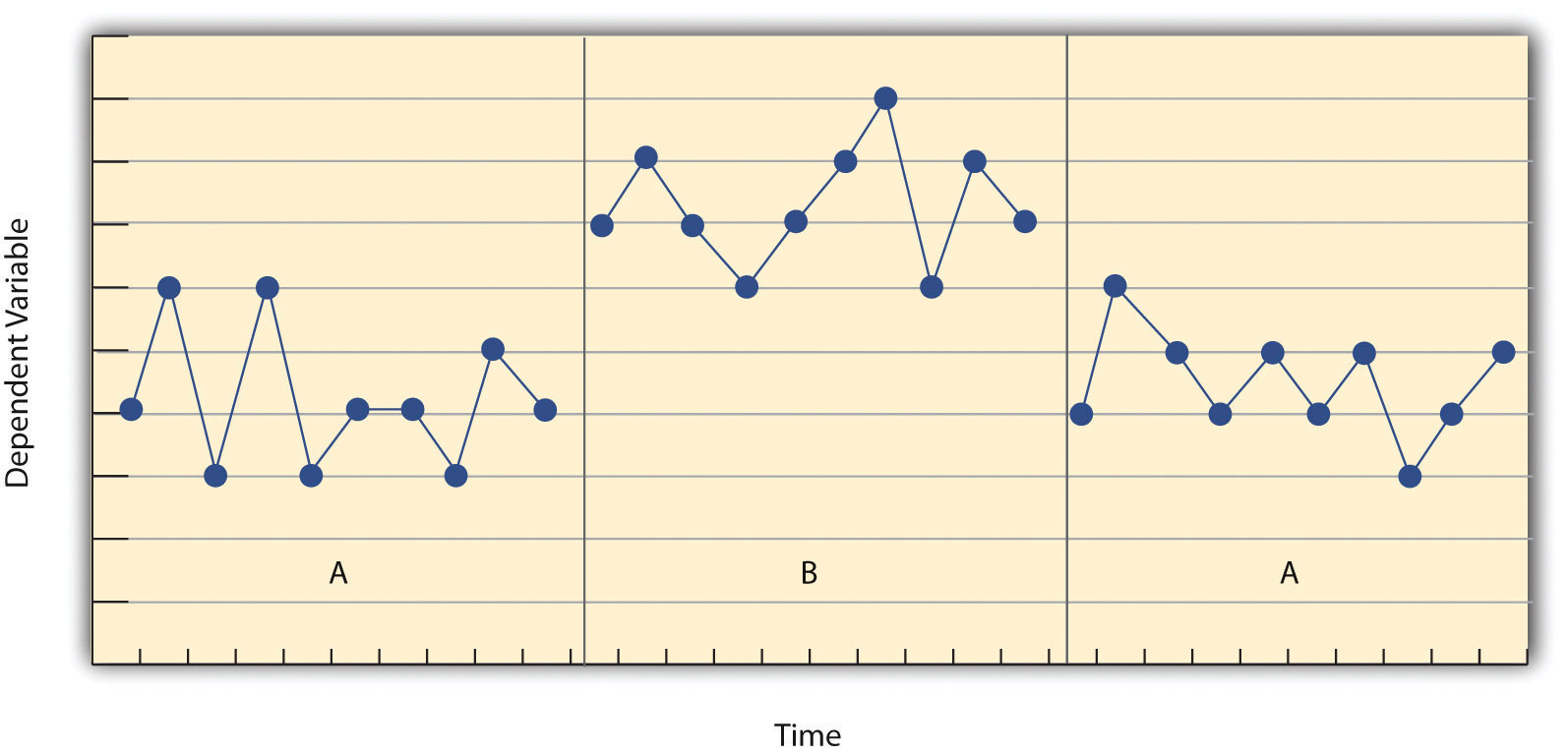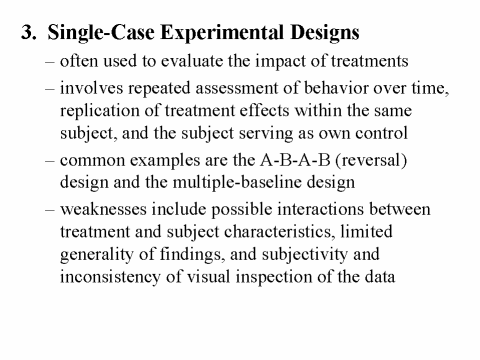The intervention involved a metacognitive contextual intervention based on a conceptualization of neurocognitive psychological and. 13 Daily ideographic measures were collected during the baseline A period of 14 days and were compared.

Quasi Experimental And Single Case Experimental Designs Ppt Download
The reasons for using idiographic research in nursing are discussed and important differences between nomothetic and idiographic designs are highlighted in this article.

. However the lack of control severely limits any conclusions that can be drawn. B contingent The ABAB design implies that the behavior is under control of the contingency. The combined number of experiments ie single-case design examples across the studies totals at least 20.
The case-study approach is often an uncontrolled inquiry into history retrospective and it may yield interesting information. The B-A-B design is used i. Recall that we encountered this same principle when discussing experimental research more generally.
In this example the dependent variable what we hope to change is the. The more data points we have the better. The A-B-A-B design is recommended for use when reversal designs can be used and when the patients treatment phase needs to be maintained.
Replications conducted by 2 independent research groups. 12 The SCED method will follow an A-B design. The most basic single-subject research design is the reversal design also called the ABA design.
Operation in designing studies 2. ABAB A noncontingent. Single-case experimental designs are a family of experimental designs that are characterized by researcher manipulation of an independent variable and repeated measurement of a dependent variable before ie baseline and after ie intervention phase introducing the independent variable.
Cause-and-effect relationships in single-case experimental research can be increased through treatments and replications Birnbrauer et al 1974. According to Kratochwill and Williams 1988 single-case experimental designs have following five characteristics. Of experimental design used single-case or group design a number of factors encom-pass external validity Poling Grossett 1986.
Single-case experimental designs. In single-case experimental designs a case is the unit of intervention. There are two serious problems with the case-study approach.
Single-subject experiments are easy to do. Example of Multiple Component Design 20. Single-Case Quasi-Experimental and Developmental Research.
Same intervention treatment protocol and duration Same target problem and sample. Group designs single-subject designs. A Methodology for Establishing Evidence-Based Practice in Special Education Faisl Alqraini Department of Special Education Prince Sattam bin Abdulaziz University Saudi Arabia Abstract In the field of special education there is a dearth of group experimental studies that establish evidence-based practice.
In this chapter we separate the content into two major sections. 1 pro-viding a rich and detailed description of the setting and the intervention 2 detail-. Single-subject experimental design is a rigorous technique for evaluation that can typically stand alone in assessing program effectiveness p.
So theres a myth about the number of data points needed. Single-case experimental designs are characterized by repeated measurements of an individuals behav ior comparisons across experimental conditions imposed on that individual and assessment of the measurements reliability within and across the con ditions. Single subject research also known as single case experiments is popular in the fields of special education and counseling.
Removal of the contingency the second A in the AB A B design and its reinstatement ABA B will test whether the behavior is maintained in the. Experimental design Effects of different interventions IVs on the same subject. Four weeks of observation baseline phase A 1 were followed by eight weeks of core stability training intervention phase B then another four weeks of observation baseline phase A 2.
But for single-case experimental design you want to see at least three data points because it allows you to see a trend in the data. Example of a single case design ABAB The above example illustrates a single case design methodology ABAB aimed at reducing anxiety demonstrated through nail-biting behavior in a 25-year old man by introducing relaxation therapy. The single-case experimental design is an example of idiographic research which involves establishing causality.
Single Case and Single System Designs Uses of SSDs and SCDs in Social Work. Quasi-experimental designs and single-case experimental designs. An example of results from a single-case A 1 BA 2 study conducted on eight participants with stable multiple sclerosis data on three participants were used for this example.
The quasi-experimental research design. Single-subject design has its own tradition of methodology. This article describes and discusses some commonly used single-case experimental designs including reversal and non-reversal designs.
Data Evaluation in Single Case Research Limitations lack of concrete decision rules. The term single-case experimental designs SCEDs refers to a set of experimental methods that can be used to test the efficacy of an intervention using a small number of patients typically one to three and involve repeated measurements sequential randomized introduction of an intervention specific data analysis and statistics. Single-Subject Designs -- also called.
Neuman and McCormick 1995 suggest that the best ways to attend to the issues of external validity include. 3 replications of 3 subjects each. 1 lack of experimental control and 2 obtaining precise measures of behavior.
The effect of an independent variable is easier to detect when the noise in the data is minimized. Of quasi-experimental research design. The Single Case Experimental Design SCED 11 has previously assessed psychological interventions in the chronic pain population and will help to establish within-participant variance.
This research design is useful when the researcher is attempting to change the behavior of an individual or a small group of individuals and wishes to document that change. Ownsworth and colleagues 54 used a single-case experimental design to test an intervention to improve daily function of a 36-year-old man 4 years after a severe traumatic brain injury who demonstrated long-term awareness deficits. For example often when she was near a window a voice.
Michael Perone and Daniel. Basically single-subject designs focus on a single individual in a research sample Alberto Troutman 1990 are the extension of the quasi-experimental studies time-series designs. Experimental and Clinical Treatments of Writing Blocks Boice 1983 Single-Case Experimental Design.
We begin this chapter with an introduction to the type of research design illustrated here. In the words of Good 2000. 131 An Overview of Quasi-Experimental Designs.

Single Case Experimental Design An Overview Sciencedirect Topics

3 Single Case Experimental Designs

Overview Of Single Case Experimental Design Sced Options With Download Scientific Diagram
Chapter 11 Single Case Quasi Experimental And Developmental Research Psy3213c 15fall 0w59

Single Subject Research Designs

Single Case Experimental Design An Overview Sciencedirect Topics
Single Subject Research Educational Research Basics By Del Siegle

0 comments
Post a Comment